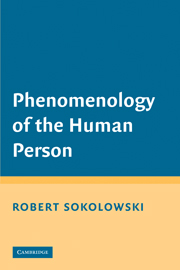Book contents
- Frontmatter
- Contents
- Acknowledgments
- Phenomenology of the Human Person
- Introduction
- PART I THE FORM OF THINKING
- PART II THE CONTENT OF THINKING
- PART III THE BODY AND HUMAN ACTION
- 12 The Body and the Brain
- 13 Active Perception and Declaratives
- 14 Mental Images and Lenses
- 15 Forms of Wishing
- 16 Declaring Our Wishes and Choices
- PART IV ANCIENTS AND MODERNS
- 19 Conclusion, with Henry James
- Bibliography
- Index
13 - Active Perception and Declaratives
Published online by Cambridge University Press: 05 June 2012
- Frontmatter
- Contents
- Acknowledgments
- Phenomenology of the Human Person
- Introduction
- PART I THE FORM OF THINKING
- PART II THE CONTENT OF THINKING
- PART III THE BODY AND HUMAN ACTION
- 12 The Body and the Brain
- 13 Active Perception and Declaratives
- 14 Mental Images and Lenses
- 15 Forms of Wishing
- 16 Declaring Our Wishes and Choices
- PART IV ANCIENTS AND MODERNS
- 19 Conclusion, with Henry James
- Bibliography
- Index
Summary
One way to study thinking is to begin with perception and work up to rational activity. In this book, we have proceeded in the opposite direction. We began, not just with thoughtful speech, but with something even higher, with the declarative appropriation of our thoughtful speech. We then analyzed the syntactic articulation that constitutes thinking and spoke about the linguistic signaling of categorial activities. We went on to treat imagination as more elementary than speech, but so far we have spoken only occasionally about perception. Now that we have introduced the topic of the body and the brain, it is appropriate to say more about perception, which is the most original mode of human experiencing, more fundamental than imagination, memory, and thinking.
The Enactive Theory of Perception
As Husserl's phenomenology shows, perception is not the mere taking in of impressions; rather, it involves an activity in which a thing is experienced as an identity within a manifold of appearances. To perceive a tree is not simply to receive a series of sensory impacts and to construct a mental model of the thing that is behind them; to perceive a tree is to move around it and to see it from many angles and in many illuminations, to touch it, to hear it rustle in the wind, to smell its scent, and so on. In all these presentations, one and the same tree is being experienced, and all the presentations are experienced as belonging to the one thing.
- Type
- Chapter
- Information
- Phenomenology of the Human Person , pp. 205 - 224Publisher: Cambridge University PressPrint publication year: 2008

